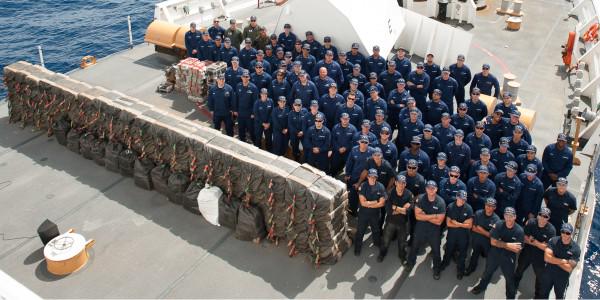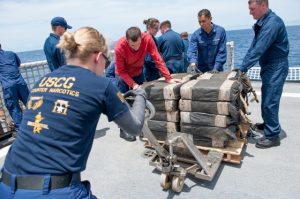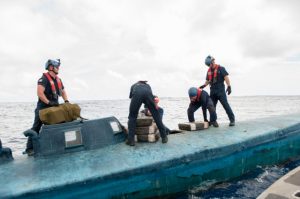
(USCG – Petty Officer 2nd Class LaNola Stone – Scroll down for video) — This blog is part of a series leading up to the offload of more than 66,100 pounds of cocaine worth $1.01 billion wholesale seized in the Eastern Pacific Ocean. This will be the one of the largest known cocaine offloads in Coast Guard history.
The drugs were seized in 37 separate interdictions by U.S. Coast Guard cutters and Coast Guard law enforcement teams operating from U.S. Navy vessels in known drug transit zones near Central and South America. As part of the offload, Coast Guardsmen will turn over 21,000 pounds of cocaine seized by the crew of Stratton during the interdiction of two different self-propelled semi-submersibles.

The operations center of the National Security Cutter, NSC, with all its moving parts, is awe-inspiring. This dedicated area aboard the cutter is just one of many features that distinguishes the newest white-hull from the legacy fleet.
There are systems to monitor everything: charts, computer monitors and giant screens light up the dark icy cold space. Operations specialists move quickly around this hive of information. They’re constantly receiving, uploading, downloading and decoding information from U.S. and partner nation assets. Their eyes focused on the large glowing screens.

A constant murmuring flow of voices is the backdrop as the watchstanders communicate with various interagency and partner nation assets in the air and on the water.
This capability to fuse this information here catapults the Coast Guard into the 21st century. It gives these frontline Coast Guardsmen the tools to fight modern threats to the United States.
The monitors began to flash as a transmission begins to create a buzz throughout the room – a maritime patrol aircraft detected a self-propelled semi-submersible sea craft (SPSS) July 18, 2015.
These craft lurk just below the surface cloaked by the sea. They’re hard to detect and even harder to catch. There have only been 29 prior interdictions of semi-submersibles by the Coast Guard in the Eastern Pacific Ocean. Stratton stopped one of those a little over a month ago.
Capt. Nathan Moore, Stratton’s commanding officer, takes the report. He quickly directs the crew to change course and intercept.
“Semi-submersibles are our ‘white buffalo,’” said Moore. “They’re extremely rare, seldom seen, but they exist. Stratton’s job is to be a front-line hunter to stop these vessels from reaching America’s shores.”
Semi-submersibles are capable of transporting large quantities of contraband in a single trip, which rewards and incentivizes their use. The Department of Homeland Security has estimated that drug submarines account for nearly 32 percent of all maritime cocaine flow between Latin America and the United States alone.
At the captain’s order, the 30,000-horsepower turbine and two 10,000-horsepower diesel engines propel the Stratton through the inky darkness of night. Boarding teams are armed, and the boats and helicopter are fueled and ready.
The crew leans forward, poised ready to strike, as they thunder toward the suspected drug sub. Stratton would not miss this opportunity to capitalize on the information received.
As the day breaks, the sun reveals a determined Coast Guard crew ready to pounce.
Two cutter small boats surge toward the target. An orange Helicopter Interdiction Tactical Squadron MH-65 Dolphin helicopter, its side bristling with a .50-caliber sniper rifle and a M-240B machine gun, lifts up from Stratton’s flight deck and turns to provide cover for the boarding team.
The three tines of Stratton’s trident vector toward the semi-submersible. The entire crew knows what is at stake. They know the importance of each bust.
Transnational organized crime networks use the money from the sale of cocaine to fund terrorism; human, weapon and drug trafficking; piracy; environmental crime; and cyber-crime. These web-like organizations prey upon a country and leave death and devastation in their wake. Their reach even extends to the United States costing American cities $193 billion each year.
Stopping these vessels prevents cocaine from hitting U.S. streets, and it hits these criminal organizations where it hurts – in the wallet.
The hunt is a short one as the Coast Guard teams swarm around the camouflaged sea-green boat.
The Coast Guard boarding team members leap aboard the smooth back of the semi-submersible. They quickly throw open the hatch, extract the crew and secure the vessel. They have positive control.
In that moment, Stratton interdicted 8.4 tons of uncut cocaine with a street value of approximately a $250 million dollars.
“With each interdiction by Stratton’s crew, the Coast Guard and its interagency partners deliver a blow to transnational organized crime networks that propagate violence and instability across the Western Hemisphere,” said Vice Adm. Charles W. Ray, commander, Coast Guard Pacific Area. “Coast Guardsmen serve on the frontlines in the effort to disrupt criminal works meeting the threat these organizations pose in our hemisphere head on.”
It took 110 Coast Guard men and women approximately 36 hours to transfer the cocaine aboard the semi-submersible to the Stratton.
The bounty of their white buffalo, now secured aboard the Stratton, represented months at sea, cooperation with interagency and partner nations, and the Coast Guard’s investment in its people and the capabilities needed to defend America against 21st century threats.
This mission was complete; however, Stratton and numerous other Coast Guard cutters continue to patrol the Eastern Pacific. Waiting. Watching. Always Ready.

